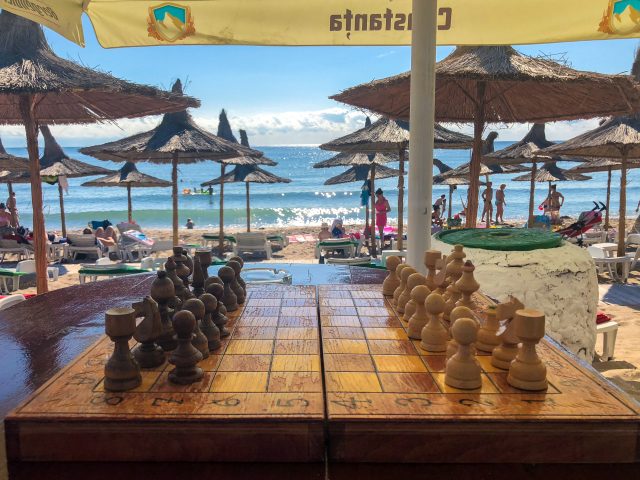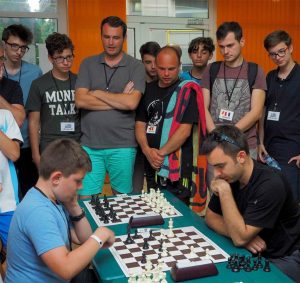 Chess on the beach, anyone?
Chess on the beach, anyone? Tournament organizer, Mariana Ionita, awards Kostya a trophy, medal, and cash for his stellar 7.5/9 finish
Tournament organizer, Mariana Ionita, awards Kostya a trophy, medal, and cash for his stellar 7.5/9 finish[pgn]
[Event "FISCA Open"]
[Site "chess24.com"]
[Date "2018.06.26"]
[Round "5"]
[White "Vasiesiu, Victor"]
[Black "Kavutskiy, Kostya"]
[Result "1/2-1/2"]
[ECO "B48"]
[WhiteElo "2295"]
[BlackElo "2397"]
[Annotator "Kostya"]
[SetUp "1"]
[FEN "4r1k1/2rp1ppp/8/4PP2/1PN5/2K5/P5PP/3R4 b - - 0 29"]
[PlyCount "60"]
[EventDate "2018.??.??"]
[SourceVersionDate "2009.02.28"]
[WhiteTeam "Romania"]
[BlackTeam "United States"]
[WhiteTeamCountry "ROU"]
[BlackTeamCountry "USA"]
{[#]} {Here was a critical moment.} 29... Rxe5 $2 {A tactical blunder, missing
White's reply.} (29... Rec8 $1 30. Rd4 f6 $1 {was another option I considered,
and should have gone for, as Black gets much more counterplay than in the game.
} 31. Kd3 (31. exf6 $2 d5 $19) 31... fxe5 32. Nxe5 Rc3+ 33. Ke4 Ra3 $11 {
where a draw is the most likely result.}) 30. Rxd7 $1 {After this nice shot
White is able to simplify into an 'easily' winning endgame.} Rc8 (30... Rxd7
31. Nxe5 $18 {[%cal Gb4b5,Ga2a4,Ge5c6,Gc3c4] and White's pawns roll very fast.
The king and knight are perfectly placed to escort the pawns home.}) 31. Rd8+
$1 {Insisting on the rook trade. Normally the side with an exchange down
should avoid trading its last rook, but here it's useful as Black will have
much less counterplay with just one rook.} Rxd8 32. Nxe5 Ra8 {I decided to try
and slow White down as much as possible before brining in the king and then
activating the rook to get counterplay.} 33. Kb3 Kf8 34. a4 Ke7 35. Nc4 Re8 36.
b5 Kd8 37. Kb4 {This doesn't lose anything but does make White's task a bit
harder.} (37. a5 {would have won in a relatively straightforward manner:} Re2 (
37... Re1 38. a6 Kc8 39. Kb4 Ra1 40. Kc5 Kb8 41. Kb6 $18 {[%cal Gc4e5,Ge5c6,
Gb6c7,Gb5b6,Gb6b7] with a winning plan of bringing the knight to c6 and then
advancing the b-pawn.}) 38. b6 Rxg2 (38... Kc8 39. a6 Kb8 40. Na5 $18 {[%cal
Ga5c6,Gb6b7] is an important winning setup--knight goes to c6 and the b-pawn
promotes.}) 39. a6 Kc8 40. b7+ Kc7 41. Na5 $1 {[%cal Ga5b7] Another winning
motif, defending the b7-pawn and pushing a7 next.} Rg1 42. a7 $18) 37... Re2
38. g4 $2 {Useful but unnecessary. Again White could have won by just pushing
the pawns forward. But of course this is easier said than done in a game where
both sides are down to their last few minutes.} (38. a5 Rxg2 39. a6 (39. b6 {
also wins thanks to an instructive line:} Rxh2 40. a6 Kc8 41. a7 Kb7 42. Na5+
Ka8 43. Kb5 $1 {[%cal Gb5a6,Gb6b7] Heading to a6.} Ra2 44. Ka6 Rxa5+ {Forced.}
45. Kxa5 Kb7 {and now the following important mechanism:} 46. Kb5 h5 47. Kc5 h4
48. Kd6 h3 49. a8=Q+ Kxa8 50. Kc7 $18 {and White is just in time.}) 39... Kc8 (
39... Rxh2 40. a7 Ra2 41. Na5 {is easy.}) 40. b6 Rg1 41. Na5 $18 {[%cal Ga6a7]
and again Black has no good answer to a7.}) 38... g6 {Black is lost either way,
so I tried to make a passed pawn as quickly as possible.} 39. a5 gxf5 40. gxf5
Rxh2 41. a6 $2 {The wrong way forward.} (41. b6 $1 {was better as after} Ra2 {
White has} 42. Kb5 {and can still advance.} h5 43. a6 h4 44. a7 h3 45. b7 $18)
41... Ra2 $1 42. Kc5 $1 (42. Na5 {leads to just a draw after} Kc8 43. a7 Rxa5
44. Kxa5 Kb7 45. a8=Q+ {The only way.} (45. b6 $4 {is a tempo too slow here:}
h5 46. Kb5 h4 47. Kc5 h3 48. Kd6 {In the previous line where we saw a similar
K+P endgame, Black had to spend a tempo on Kb7. But here I'm right on time:} h2
49. a8=Q+ Kxa8 50. Kc7 h1=Q $19) 45... Kxa8 46. Kb6 {[%cal Gb6c7] Threatening
Kc7, and White draws thanks to Reti's famous study idea - combining the threat
of advancing the b-pawn with the chase of the passed h-pawn:} Kb8 47. Kc6 h5
48. Kd5 Kb7 49. Ke5 Kb6 50. Kf4 Kxb5 51. Kg5 Kc5 52. Kxh5 {with a draw after}
Kd5 53. Kg5 Ke5 54. f6 Ke6 55. Kg4 Kxf6 56. Kf4 $11) 42... Kc8 $2 {From this
moment on there are many mistakes made by both sides, often changing the
evaluation from drawn to lost back to drawn. I'm sure many of us have had
games like this--in my opinion the best thing to do is to try and learn from
the different resources missed!} (42... Kc7 $1 {would save the day, not
allowing White's king to enter. After} 43. b6+ Kb8 44. a7+ Ka8 45. Ne5 h5 $11 {
Black has enough counterplay to survive, as White has no way of forcing the
pawns through.}) 43. Nd6+ (43. Kb6 $1 {was the only win:} Kb8 44. Ne5 h5 45.
Nc6+ Ka8 46. Kc7 $1 $18 {[%cal Gb5b6,Gb6b7] The key idea, threatening to
advance b6-b7.} Rxa6 {falls short after} 47. bxa6 h4 48. Ne5 h3 49. Nf3 $18)
43... Kb8 $2 ({Again} 43... Kc7 $1 {was best, inducing White to play} 44. b6+
Kb8 45. a7+ Ka8 $11 {where there is no way to force the b-pawn through or give
Nc7+ comfortably.} 46. Nb5 h5 47. Nc7+ $4 Kb7 48. a8=Q+ Rxa8 49. Nxa8 h4 $19 {
and Black wins!}) 44. Nxf7 h5 45. Kb6 $2 (45. Ne5 $1 {was good, making way for
the f-pawn.} h4 46. Nc6+ Ka8 47. f6 h3 48. b6 $1 Rb2 49. f7 $18 {and Black's
rook can't defend against both the b- and f-pawns.}) 45... h4 46. Ng5 Rd2 (
46... h3 $1 {was the only saving move at this point.} 47. Nxh3 Rd2 $1 48. Nf4
Rd6+ 49. Kc5 Rf6 50. Nd5 Rxf5 51. b6 Rh5 $11 {and this is a known theoretical
draw. Black should be able to keep White from making progress by always being
ready to sacrifice the rook for the remaining two pawns.}) 47. a7+ Ka8 48. Ne6
{Black still has an important h-pawn left on the board, which will prove to be
a valuable source of counterplay. Now because White is threatening Nc7#, I
played the only reasonable move to continue the game:} Rd6+ {Displacing
White's king to give my own king some air.} 49. Kc5 $2 {Missing an easy finish.
} (49. Kc7 $1 {was decisive though a bit counter-intuitive (White was angling
to put his knight on this square) -- the threat of b6-b7 is too strong.} Rd1 ({
A key line is that} 49... h3 {wins the race but still loses the game for Black:
} 50. Kxd6 h2 51. b6 h1=Q 52. Nc7+ Kb7 53. a8=Q+ $1 {and White wins.}) 50. b6
Rb1 {Black stops the threat of b7, but now} 51. f6 $18 {and White's f-pawn
will queen with mate.}) 49... Rd1 $2 {Giving White another chance to finish
off the game.} (49... Rd7 $1 {would hold the draw, the point is Black's rook
stands excellently defending along the 7th rank.} 50. b6 Kb7 51. f6 h3 52. Nc7
Rd8 $11 {transposes to the nice finish in the game.}) 50. b6 (50. Kb6 $18 {
would force Rd6+ after which White can revert to the winning line with Kc7.})
50... Kb7 {Forced, otherwise Nc7+ and White will queen the a-pawn.} 51. Nc7 $2
{Finally blowing the win for good, and giving Black a chance to make a pretty
draw.} (51. f6 $1 {was winning, but by a very slim margin. This often happens
in chess, with each missed chance the winning line becomes more and more
difficult to spot. This was certainly the case here.} Rc1+ (51... h3 {is again
too slow:} 52. f7 Rf1 53. Nc7 $1 $18 {and one of White's pawns will queen.})
52. Kb4 $3 {The only winning idea.} {After} Rc8 (52... Rb1+ 53. Ka3 Kxb6 $1 54.
f7 Rf1 55. Nf4 $3 {A study like solution--good luck finding this one with 30
seconds on your clock!} Rf3+ 56. Kb2 Rxf4 57. a8=Q Rxf7 58. Qe4 $18 {and White
will reach a queen vs. rook endgame, which is winning theoretically but can be
difficult in practice.}) 53. Kb5 $1 h3 54. Nc5+ $1 Rxc5+ 55. Kxc5 {Black
queens first but gets mated by force:} h2 56. f7 h1=Q 57. a8=Q+ Kxa8 58. f8=Q+
Kb7 59. Qf7+ Ka6 60. Qa7#) 51... Rd8 $1 {I spotted this drawing idea a while
back -- Black will give the rook for White's first pawn to promote, giving
Black just enough time to promote the h-pawn.} 52. a8=Q+ Rxa8 53. Nxa8 h3 $1 {
This was the key move missed by my opponent. Of course in heavy time trouble
it is natural to assume Kxa8 is 'forced', and not notice that Black has
another, very important option in the position.} ({After} 53... Kxa8 $2 54. f6
$18 {White queens with check and wins easily.}) 54. f6 h2 55. f7 h1=Q 56. f8=Q
{Black gets the first move in this new endgame, and because White's knight is
so terribly placed, an easy draw is achieved by checking the king and
eventually picking up the knight on a8. If White's king is pushed far away
(anywhere that cannot reach the c6-square in one move), Black can take the
knight with Qxa8 and offer to go into a drawn king and pawn endgame.} Qc1+ 57.
Kb5 (57. Kd5 Qd2+ 58. Ke6 Qa2+ 59. Kf6 Qxa8 $11 {with a simple draw.}) 57...
Qb2+ 58. Kc4 ({Unfortunately for White, even} 58. Qb4 Qxb4+ 59. Kxb4 Kxa8 $11 {
is a trivial draw.}) ({After} 58. Ka5 {Black can keep checking on the a-file
but much smoother is} Qb5+ $1 {as pointed out by Eric after the game:} 59. Kxb5
$11 {with a lovely stalemate.}) 58... Qa2+ 59. Kd4 {and a draw was agreed. A
miracle save by any standard!} 1/2-1/2
[/pgn]
After this bit of fortune I scored 2.5/3 in the next few games to reach 6.5/8, which was good for shared second with three other players behind the leader, GM Murariu who was on 7/8. The highest rated of these players, IM Teodor Anton, faced Murariu in the final round, the other two players on 6.5/8 faced each other on Board 2, while I played Black against FM Catalin Miroiu, who was on 6/8. It was a bit of bad luck to be paired against Catalin, as Eric and I met him earlier in the blitz event and had since hung out with him a few times, enough to consider him a local friend. But it was good fortune that he was half a point behind, as the tournament situation compelled him to play for a win and sharpen the game.
Knowing that a win would give me a much higher place than a draw, even chances to take first, I was happy to play a sharp King’s Indian, which seemed suitable for Catalin as well. I found myself in control in the middlegame, with a free hand to attack on the kingside and a big time advantage, but several inaccurate moves caused me to lose almost the entirety of the advantage, keeping an extra pawn that was hard to push. Despite having caught up on time, with both players now playing on increment, I was able to maneuver my way into making slow progress and eventually converted after 112 moves! Here’s the game:
[pgn]
[Event "2018 FISCA Open"]
[Site "chess24.com"]
[Date "2018.06.30"]
[Round "9.3"]
[White "Miroiu, George-Catalin"]
[Black "Kavutskiy, Kostya"]
[Result "0-1"]
[ECO "E94"]
[WhiteElo "2373"]
[BlackElo "2397"]
[Annotator "Kostya Kavutskiy"]
[PlyCount "224"]
[EventDate "2018.??.??"]
[SourceVersionDate "2009.02.28"]
[WhiteTeam "Romania"]
[BlackTeam "United States"]
[WhiteTeamCountry "ROU"]
[BlackTeamCountry "USA"]
1. d4 Nf6 2. c4 g6 3. Nc3 Bg7 4. e4 d6 5. Be2 O-O 6. Nf3 Na6 7. O-O e5 8. Be3
c6 9. d5 Ng4 10. Bg5 f6 11. Bh4 c5 {I've played this structure a few times now,
where White's bishop on h4 does a good job of slowing down Black's counterplay,
but is also missed on the queenside where it's harder for White to break
through.} 12. Ne1 Nh6 13. a3 Nf7 14. Nd3 Bd7 15. b4 b6 16. Rb1 h5 17. h3 Bh6
18. Rb2 Qe7 19. Re1 Kh8 20. Bf1 Rg8 21. Bg3 Rac8 22. Nb5 Be8 {Up until this
point both sides have chosen relatively normal moves. The structure is quite
complex and resembles one of those classic 'King's Indian' type middlegames
but with a key difference - White's dark-squared bishop sits on the kingside,
where it slows down Black's play but is also of little use to White on the
queenside. Strategically, it is hard for either side to advance without
allowing counterplay for the other side.} 23. Qa4 $6 {The first slip of the
game. White puts himself in a pin in order to cause concrete problems
(attacking both the knight on a6 and pawn on a7) but there's a nice refutation
of the idea.} ({A move like} 23. Rc2 {would keep the balance. The engines
typically give White a serious advantage here, but in practice the position is
quite double-edged and all three results are certainly still possible.}) 23...
Nc7 $1 24. bxc5 {Forced, otherwise Black was ready to win a piece with a6.} ({
The point is} 24. Qxa7 $2 {would get the queen trapped after} Bxb5 $1 25. cxb5
Ra8 26. Qxb6 Rgb8 27. Qc6 Nd8 $19) 24... Nxb5 {This allows White a surprising
sacrifice.} (24... a6 $2 25. cxb6 axb5 26. Qa7 $1 {would be good for White.}) (
24... bxc5 {was objectively best. The a7-pawn is still poisioned and Black is
ready to take on b5 and get a passed c-pawn next. Black is probably slightly
better after Nxb5 and Bd7 next.}) 25. cxb5 (25. cxb6 $1 {was apparently worth
trying.} Nc3 26. Qa6 Ra8 27. b7 Rb8 28. Qxa7 Qc7 29. c5 $1 {and things fizzle
out to a draw according to Stockfish. I doubt either player considered this
possibility with any seriousness, however.}) 25... dxc5 $15 {[%csl Gg6][%cal
Gf7d6,Gg6g5,Gh5h4,Gg5g4] Now the structure has changed in Black's favor, as
I'm ready to put a knight on d6, completely securing the queenside before
advancing g5, h4, and g4, opening up the g-file for a direct kingside attack.}
26. Rc2 Nd6 27. Nb2 g5 28. Qb3 Bd7 29. a4 h4 30. Bh2 g4 31. Kh1 Rg6 (31... Qh7
$1 {[%cal Gh7e4] Hitting the e4-pawn was even stronger.}) 32. hxg4 Rxg4 33. Qf3
Rcg8 34. g3 $6 {Making matters a lot worse. It's important to point out that
here White was down to just a few minutes for the rest of the game, relying on
the 30-second increment not to flag. I had plenty of time left and was feeling
confident, though a bit nervous as I realized I'm playing for the win (and 1st
place in the tournament!).} (34. Nc4 Nxc4 35. Bxc4 R8g7 $17 {Black can
continue building up on the g-file and eventually prepare the break h4-h3.})
34... R4g6 (34... f5 $1 $19 {was already quite strong, but I wanted to keep
control over the position for as long as possible.}) 35. Nc4 R8g7 36. Nxd6 Qxd6
37. Bc4 Bg4 38. Qd3 hxg3 39. fxg3 (39. Bxg3 Bf4 $19 {[%cal Gg7h7] and White
will get mated along the h-file.}) 39... Rg5 40. Rf2 Rh5 41. Qf1 Bg5 42. Be2
Bh3 43. Qg1 Rh6 44. Bd1 c4 $1 {The principle of two weaknesses. White has his
hands full defending the kingside, so it's the right time to push the c-pawn
forward and infiltrate with the queen.} 45. Rc2 Rc7 (45... Qb4 $19 {was also
good.}) 46. Bf3 Qa3 47. Qf2 Qxa4 $6 {Getting sidetracked by unimportant pawns!
To be honest I thought I could win any number of ways here, and while that's
objectively true, it runs the risk of spoiling the advantage with 1 or 2
inaccurate moves.} (47... Rch7 $1 {was the cleanest, piling up on the bishop
on h2.} 48. Bd1 {would be forced so that the bishop doesn't hang on f3. And
now after} c3 $19 {[%cal Gg5d2,Gh3d7] White would have no moves and can resign
soon, as Bd7 is coming next, as well as Bd2!}) 48. Rb1 c3 49. d6 Rd7 $2 {
Giving up a large portion of the advantage.} (49... Rch7 {was still best, with
the point} 50. Rxc3 Bg4 $1 51. Bxg4 Rxh2+ 52. Qxh2 Qxe4+ $19 {and Black takes
everything. In fact it's Mate in 9.}) 50. Rxc3 Rxd6 {[%cal Gd6d2] Threatening
Rd2, I thought the game was over but} 51. Qc2 $1 {Forcing a queen trade. I
could play 51...Qd4 52.Rd1 Bd2 here, but that seemed quite awkward. Instead I
go for the pawn-up endgame which is still winning for Black.} Qxc2 52. Rxc2 Be6
53. Rd1 Rxd1+ 54. Bxd1 Rh7 {[%cal Gh7d7,Gd7d4,Gg5e3,Ge3c5]} (54... Be3 $1 {
was a lot cleaner, planning to cement the bishop on c5. Rc7 can be met with
Rh7!}) 55. Kg2 Be3 56. Rc6 Re7 $6 (56... Bh3+ {was the last chance to keep a
decisive advantage.} 57. Kf3 Bd4 58. g4 (58. Rxf6 Bf1 $19 {[%cal Gf1b5,Gh7h2]
White is losing a piece.}) 58... Rg7 59. Kg3 Bf1 60. Rxf6 Bxb5 $19 {Things are
by no means easy here but the connected passers secure a win with correct play.
}) 57. Bg1 Bxg1 58. Kxg1 Kg7 $17 {On the surface this endgame still looked
like an "easy win". Black is up a pawn and any trade of pieces simply helps
Black, as White's pawn on b5 is going to be a target for the rest of the game.
As it turns out, White can make things difficult for Black by keeping the rook
active and consistently threatening the a7-pawn. By now I had caught up to my
opponent on time (3 minutes each). Given this, in addition to the fact that I
had squandered a huge advantage earlier, and with the entire tournament on the
line, the psychological pressure in this moment was quite palpable. I thought
of other last round games where I messed things up just as badly, but deep
down I also knew that my winning chances here were quite serious, so I did my
best focus on the game and look for ways to improve my position.} 59. Be2 Kf8
60. Kf2 Ke8 61. Ke3 ({Neither player thought} 61. Bc4 $5 {was useful here for
White, but after} Bxc4 62. Rxc4 Kd7 63. Ke3 $15 {White is holding here,
according to Stockfish. Still, it would not be an easy defense, as Black is
always looking to put the king on c5 and win the b5-pawn, securing two
connected passed pawns.}) 61... Kd7 62. Rc1 Rg7 63. Kf2 Kd6 64. Rc6+ Kd7 65.
Rc1 Rh7 66. Ke3 Rh3 67. Kf2 Rh2+ 68. Ke3 Rh8 69. Ra1 Ra8 {A sad necessity, but
I felt this passivity was temporary.} 70. Rh1 Kd6 71. Rd1+ Ke7 (71... Kc5 72.
Rc1+ Kb4 73. Rb1+ {and it's not clear how to make progress.}) 72. Ra1 Bd7 73.
Ra2 Be8 74. Ra1 Kd6 75. Rd1+ Ke7 76. Ra1 Bf7 77. Ra3 Kd6 78. Ra1 Bb3 $1 {
A nice way to confuse White's coordination.} 79. Ra3 Be6 80. Ra1 (80. Rd3+ Kc5
$1 81. Rc3+ Kb4 82. Rc6 Bd7 83. Rc1 Rc8 $17 {and Black is close.}) 80... Rg8 $1
{The point of Black's previous play. With the 7th rank cleared, I can gain an
important tempo by hitting the g3-pawn and then place my rook on g7, ready to
go to c7.} 81. Kf2 (81. Rxa7 Rxg3+ 82. Kd2 Rg2 83. Ke3 Bc8 $15 {was not
winning for Black, but the game goes on.}) 81... Rg7 82. Rc1 (82. Rd1+ Kc5 83.
Rc1+ Kb4 84. Rc6 Bb3 85. Rxf6 Ba4 $19 {and Black wins.}) 82... Rc7 83. Rd1+ Ke7
84. Ra1 Bf7 85. Ra3 Bg6 86. Ke3 {I've made a lot of progress as all my pieces
are placed well, but still there's no immediate breakthrough and I have to
keep the 50-move rule in mind. I decided to put my king on g5 before finding
the right time to activate the rook.} Kf8 87. Bd3 Kg7 88. Ra1 Kh6 89. Rh1+ Kg5
90. Rh8 Rc3 $1 {[%cal Gc3a3]} 91. Rg8 Ra3 {Combining attack with defense,
always a sound strategy.} 92. Kd2 Kh6 93. Rc8 Ra2+ 94. Ke3 Ra5 95. Bc4 $2 {
The decisive mistake, allowing a surprising resource.} (95. Rd8 Bf7 $17 {
and the game goes on. Next I would try to bring my king back to e7 and play
Be8 to target the b5-pawn.}) 95... Ra3+ $1 {I've inadvertently triangulated
with my rook! Now White has to choose between giving up a pawn or playing Bd3.}
96. Bd3 f5 $1 {The point. White loses another pawn and with it the game.} 97.
Kd2 (97. exf5 Bxf5 98. Rd8 e4 $1 $19 {and it's game over.} ({Of course not}
98... Rxd3+ $4 99. Rxd3 Bxd3 100. Kxd3 Kg5 101. Ke4 {Where it is White who
wins thanks to the more active king and outside passed pawn:} Kg4 102. Kxe5
Kxg3 103. Kd6 Kf4 104. Kc7 Ke5 105. Kb7 Kd5 106. Kxa7 Kc5 107. Ka6 $18)) 97...
fxe4 98. Be2 e3+ 99. Kd1 Ra1+ 100. Rc1 Ra2 101. Rc3 Ra1+ 102. Rc1 Rxc1+ 103.
Kxc1 Kg5 104. Kd1 Be8 {Black is obviously winning, but there's still no need
to rush. I kept my calm and won methodically.} (104... Bh5 {was already
winning, but I felt no need to calculate the line when it wasn't necessary:}
105. Bxh5 Kxh5 106. Ke2 Kg4 107. Kxe3 Kxg3 108. Ke4 Kf2 109. Kxe5 Ke3 110. Kd5
Kd3 111. Kc6 Kc4 $19) 105. Kc2 Kf5 106. Kc3 Ke4 107. Kc4 Bf7+ 108. Kc3 Be6 109.
Kc2 Bh3 110. Kd1 Bg2 111. g4 Kf4 112. Kc2 Bf3 {A marathon game, and the last
to finish in the entire event! While I was happy with my middlegame play to
secure a decisive advantage, I felt prouder of my psychological resilience to
keep pushing for the win after I had realized how badly I had blown it. A
memorable experience for sure.} 0-1
[/pgn]
The top two boards in front of me both drew, allowing me to catch Murariu and tie for first place with 7.5/9. He had better tiebreaks throughout the event and deservedly took first, while I was quite happy to earn clear second after such a tough event.
 The winners! Kostya also took home 1500 Romanian Leu for his efforts
The winners! Kostya also took home 1500 Romanian Leu for his efforts
Eric's Perspective: A less desirable result, but still an epic experience.
by Eric Rosen
While my tournament performance was far less desirable than Kostya's, I must echo everything said about the tournament conditions. It's hard to complain with spending 10 days on the Romanian seaside, enjoying perfect weather and surrounded by delicious food and friendly people. This is one of the things I love about traveling to interesting and exotic places for chess: It's much easier to move on from a disappointing game (or several games in my case) when you're in a great environment.
 Pre-game and post-game relaxatoin
Pre-game and post-game relaxatoinMy start to the tournament was quite smooth. Going into round 6, I was tied for first place with 4.5/5, having given up only one draw to Kostya. I found myself on board 1 sitting across from the top seed, GM Andrei Murariu. After a nice opening with the black pieces, I failed to capitalize on my advantage. After a few inaccuracies, my opponent quickly got a crushing attack and finished me off in spectacular fashion. Here's the game:
[pgn][Event "FISCA Open"]
[Site "chess24.com"]
[Date "2018.06.28"]
[Round "6.1"]
[White "Murariu, Andrei"]
[Black "Rosen, Eric"]
[Result "1-0"]
[ECO "C54"]
[WhiteElo "2504"]
[BlackElo "2355"]
[Annotator "Eric Rosen"]
[PlyCount "57"]
[EventDate "2018.??.??"]
[WhiteTeam "Romania"]
[BlackTeam "United States"]
[WhiteTeamCountry "ROU"]
[BlackTeamCountry "USA"]1. e4 e5 2. Nf3 Nc6 3. Bc4 Bc5 4. c3 Nf6 5. d3 a6 6. Bb3 Ba7 7. Nbd2 O-O 8. h3
Re8 9. Nf1 d5 10. Qe2 h6 11. g4 Na5 12. Bc2 {Around this point, I felt like
the opening was a success for black. I've castled, developed my pieces, and
have nice central control, while white has played a bit slowly. However it is
necessary that black play accurately in this critical moment to maintain an
advantage.} Nh7 $6 {The wrong decision. I was scared of the g5 break and
responded with passivity rather than aggression} (12... Bd7 $1 {A powerful
idea which I overlooked. Black plans a series of in-between moves if white
proceeds with g5} 13. g5 (13. a4 {Preventing Bb5 ideas, but creating a
weakness on b3} dxe4 14. dxe4 Be6 $15 {Bc4 is now coming and white is unable
to play b3}) 13... dxe4 $1 14. dxe4 Bb5 $1 15. Qd2 hxg5 16. Qxd8 Raxd8 17. Bxg5
Nc4 $15 {Upon trading queens, black's king is completely safe and now white is
under serious pressure}) 13. Ng3 Nf8 $2 {Being oblivious to danger and
allowing white's key breakthrough} (13... d4 $5 {Would have led to a much
closer fight with roughly equal chances for both sides}) 14. g5 $1 {The start
of incredible "flow" for white. For the rest of the game, every move felt like
a punch in the face.} hxg5 15. Bxg5 f6 16. Bd2 dxe4 17. dxe4 Be6 18. Rg1 Bc4
19. Bb3 $1 {A strong resource which I somehow overlooked. The bishop on c4 is
now pinned and black runs out of counterplay.} b5 20. Bxc4+ Nxc4 21. O-O-O g6
22. Nh4 Kf7 23. Bh6 Qe7 24. Ngf5 $1 {As Ben Finegold would say... "Knife f5!"}
Qc5 (24... gxf5 25. Qh5+ Ke6 26. exf5#) 25. Bxf8 Qxf2 26. Rd7+ Ke6 (26... Kxf8
27. Nxg6+) 27. Rgd1 Nd6 {While nearly all of white's pieces are hanging, mate
is inevitable. A truly beautiful finish by Murariu!} 28. Rxc7 $1 Qxe2 29. Rxd6#
1-0[/pgn]
After losing to Murariu, I struggled to recover. In the following rounds, I encountered some quite talented Romanian youth who posed me with many challenges.
 Never underestimate a young chess player from Romania!
Never underestimate a young chess player from Romania!For most tournaments that I play these days, I have two main goals: Enjoy myself, and take away some valuable lessons. For this event, I feel certain that I accomplished both. While I could spend hours delving into all the lessons learned, it would be easier to simply share the YouTube videos that Kostya and I put together throughout the event. After each round we candidly analyzed our games without engine analysis. This offered a great outlet to not only vent about a disappointing loss, but also provide some valuable educational content for the online audience.
[youtube https://www.youtube.com/watch?v=videoseries?list=PLdT3OotRiHJlrWgbrqxfr1_4nZuit6MFi&ecver=2]
I would like to personally thanks Mariana Ionita and all the arbiters made this a spectacular event. I would also like to thank Radu Chirila, the father of Cristian Chirila, for allowing us to hitch a ride with him, for the 3-hour trek to Bucharest
 L to R: Eric, FM Robert Nastase, Radu Chirila, Kostya
L to R: Eric, FM Robert Nastase, Radu Chirila, KostyaCategories
Archives
- December 2025 (25)
- November 2025 (29)
- October 2025 (39)
- September 2025 (27)
- August 2025 (29)
- July 2025 (43)
- June 2025 (25)
- May 2025 (24)
- April 2025 (29)
- March 2025 (29)
- February 2025 (20)
- January 2025 (24)
- December 2024 (34)
- November 2024 (18)
- October 2024 (35)
- September 2024 (23)
- August 2024 (27)
- July 2024 (44)
- June 2024 (27)
- May 2024 (31)
- April 2024 (51)
- March 2024 (34)
- February 2024 (25)
- January 2024 (26)
- December 2023 (29)
- November 2023 (26)
- October 2023 (37)
- September 2023 (27)
- August 2023 (37)
- July 2023 (47)
- June 2023 (33)
- May 2023 (37)
- April 2023 (45)
- March 2023 (37)
- February 2023 (28)
- January 2023 (31)
- December 2022 (23)
- November 2022 (32)
- October 2022 (31)
- September 2022 (19)
- August 2022 (39)
- July 2022 (32)
- June 2022 (35)
- May 2022 (21)
- April 2022 (31)
- March 2022 (33)
- February 2022 (21)
- January 2022 (27)
- December 2021 (36)
- November 2021 (34)
- October 2021 (25)
- September 2021 (25)
- August 2021 (41)
- July 2021 (36)
- June 2021 (29)
- May 2021 (29)
- April 2021 (31)
- March 2021 (33)
- February 2021 (28)
- January 2021 (29)
- December 2020 (38)
- November 2020 (40)
- October 2020 (41)
- September 2020 (35)
- August 2020 (38)
- July 2020 (36)
- June 2020 (46)
- May 2020 (42)
- April 2020 (37)
- March 2020 (60)
- February 2020 (38)
- January 2020 (45)
- December 2019 (34)
- November 2019 (35)
- October 2019 (42)
- September 2019 (45)
- August 2019 (56)
- July 2019 (44)
- June 2019 (35)
- May 2019 (40)
- April 2019 (48)
- March 2019 (61)
- February 2019 (39)
- January 2019 (30)
- December 2018 (29)
- November 2018 (51)
- October 2018 (45)
- September 2018 (29)
- August 2018 (49)
- July 2018 (35)
- June 2018 (31)
- May 2018 (39)
- April 2018 (31)
- March 2018 (26)
- February 2018 (33)
- January 2018 (30)
- December 2017 (26)
- November 2017 (24)
- October 2017 (30)
- September 2017 (30)
- August 2017 (31)
- July 2017 (28)
- June 2017 (32)
- May 2017 (26)
- April 2017 (37)
- March 2017 (28)
- February 2017 (30)
- January 2017 (27)
- December 2016 (29)
- November 2016 (24)
- October 2016 (32)
- September 2016 (31)
- August 2016 (27)
- July 2016 (24)
- June 2016 (26)
- May 2016 (19)
- April 2016 (30)
- March 2016 (36)
- February 2016 (28)
- January 2016 (32)
- December 2015 (26)
- November 2015 (23)
- October 2015 (16)
- September 2015 (28)
- August 2015 (28)
- July 2015 (6)
- June 2015 (1)
- May 2015 (2)
- April 2015 (1)
- February 2015 (3)
- January 2015 (1)
- December 2014 (1)
- July 2010 (1)
- October 1991 (1)
- August 1989 (1)
- January 1988 (1)
- December 1983 (1)







